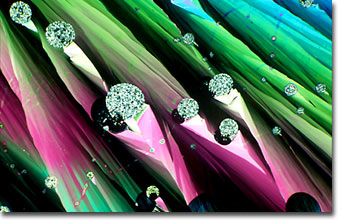Spike (M.I.) Walker
Thymolphthalein, Benzophenone, and Sulfur Complex
English photomicrographer Spike (M.I.) Walker has been a consistent winner of the Nikon Small World competition for many years and has published many articles and a book about microscopy. Featured below is a photomicrograph of a mixture containing thymolphthalein, benzophenone, and sulfur.

|
The three materials (thymolphthalein, benzophenone, and sulphur) were mixed together on a microscope slide and melted under a cover glass. As soon as melting of all the constituents was complete, the cover glass was pressed down in order to reduce the thickness of the preparation and the slide quickly removed from the hotplate (an inverted electric iron is a good substitute). The specimen was photographed under crossed polarized illumination. The objective was a plan apochromat 10x/0.32 NA coupled to an achromatic condenser. The microscope was a Zeiss Ultraphot III equipped with an automatic 35-millimeter photohead. The film was Fujichrome Velvia. (10x) |
Thymolphthalein is an indicator chemical that changes color with variations in the hydrogen ion (pH) concentration of aqueous solutions. It is often used by chemists to titrate basic or acidic chemicals during the determination of ionization and association constants.
Also known as diphenylketone, benzophenone is widely utilized in the perfume industry and in the manufacture of medicinal agents. The purified chemical is a white crystalline solid at room temperature and has a relatively low melting point around 48 degrees Centigrade.
Sulphur, the primary constituent of the mixture photographed above, is a nonmetallic chemical element belonging to the oxygen family (Group VIa of the periodic table) and is one of the most reactive of the elements. Pure sulfur is a tasteless, odorless, brittle solid that is pale yellow in color, a poor conductor of electricity, and insoluble in water. It was known to the ancients and referred to as brimstone in the Old Testament. Sulphur was first classified as an element in 1777 by Antoine Lavoisier and is estimated to be the ninth most abundant element in the universe. It makes up about 0.03 percent of the Earth's crust and is the most abundant constituent of minerals.
Free sulphur occurs primarily in volcanic or sedimentary deposits throughout the world, with heavy concentrations located in the sediments of the Gulf coast of North America. Sulphur compounds can be found in coal, petroleum, and natural gas and in sulfide ores such as pyrite (iron disulfide), galena (lead sulfide), cinnabar (mercury sulfide), sphalerite (zinc sulfide), and chalcopyrite (copper iron sulfide), as well as sulfates such as gypsum (calcium sulfate) and barite or heavy spar (barium sulfate).
